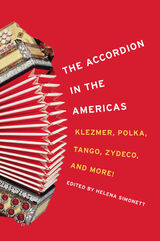
This rich collection considers the accordion and its myriad forms, from the concertina, button accordion, and piano accordion familiar in European and North American music to the exotic-sounding South American bandoneon and the sanfoninha. Capturing the instrument's spread and adaptation to many different cultures in North and South America, contributors illuminate how the accordion factored into power struggles over aesthetic values between elites and working-class people who often were members of immigrant and/or marginalized ethnic communities. Specific histories and cultural contexts discussed include the accordion in Brazil, Argentine tango, accordion traditions in Colombia and the Dominican Republic, cross-border accordion culture between Mexico and Texas, Cajun and Creole identity, working-class culture near Lake Superior, the virtuoso Italian-American and Klezmer accordions, Native American dance music, and American avant-garde.
Contributors are María Susana Azzi, Egberto Bermúdez, Mark DeWitt, Joshua Horowitz, Sydney Hutchinson, Marion Jacobson, James P. Leary, Megwen Loveless, Richard March, Cathy Ragland, Helena Simonett, Jared Snyder, Janet L. Sturman, and Christine F. Zinni.

Once a wildly popular form of Spanish entertainment, the zarzuela boasts a long history of bridging classical and popular art. Yet its contradictions make it a theatrical chameleon. Neither opera nor serious drama, the staging still requires trained singers and good actors. Neither purely folkloric nor high art, the music is too popular for some and too classical for others.
Janet L. Sturman traces the zarzuela's colorful history from its origins as a Spanish court entertainment to Cuba's pivotal role in transmitting it to Latin America and the Caribbean. Ranging from Argentina, Mexico, and Puerto Rico to El Paso, Miami, and New York, Sturman draws distinctions among the ways various Spanish-speaking communities have reformulated zarzuela by combining the traditional model with local characters, music, dances, and politics. She also explores two theaters in New York, Repertorio Español and the Thalia Spanish Theatre, that have fostered the zarzuela by mounting innovative productions that cultivate both audiences and a network of donors.
Vivid and revealing, Zarzuela recognizes the enduring cultural and social relevance of a genre at once resilient, adaptable, and temptingly elusive.
READERS
Browse our collection.
PUBLISHERS
See BiblioVault's publisher services.
STUDENT SERVICES
Files for college accessibility offices.
UChicago Accessibility Resources
home | accessibility | search | about | contact us
BiblioVault ® 2001 - 2024
The University of Chicago Press









